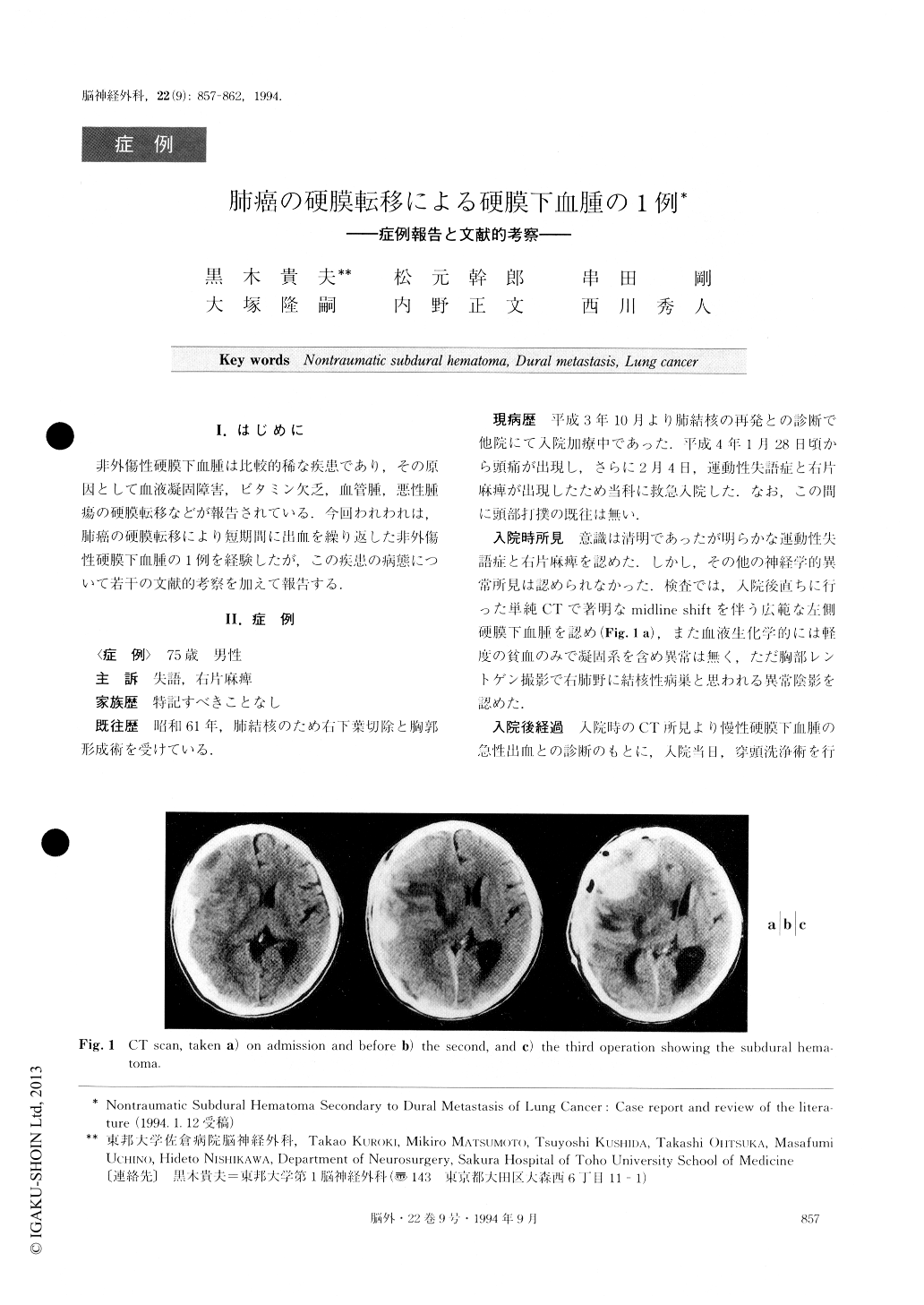Japanese
English
- 有料閲覧
- Abstract 文献概要
- 1ページ目 Look Inside
I.はじめに
非外傷性硬膜下血腫は比較的稀な疾患であり,その原因として血液凝固障害,ビタミン欠乏,血管腫,悪性腫瘍の硬膜転移などが報告されている.今回われわれは,肺癌の硬膜転移により短期間に出血を繰り返した非外傷性硬膜下血腫の1例を経験したが,この疾患の病態について若干の文献的考察を加えて報告する.
In this paper, a case of nontraumatic subdural hema-toma secondary to dural metastasis of lung cancer was presented and 43 cases in the literature were reviewed.
A 75-year-old man who had been affected with lung tuberculosis for the previous 7 years was admitted to our hospital because of right hemiparesis and aphasia. No history of head injury was discovered. On admis-sion, he was fully conscious and no other neurological abnormalities were noticed except for right hemiparesis and motor aphasia. The chest X-ray revealed abnormal shadows on the right lung, which were most suggestive of tuberculosis. Laboratory studies including prothrom-bin time, platelet count and fibrinogen were normal. The CT scans taken at that time demonstrated a large subdural hematoma over the left hemisphere. Under a diagnosis of chronic subdural hematoma, emergency evacuation through a small burr hole was performed. However, because of its low liquidity, the hematoma was insufficiently removed. Postoperatively, hemi-paresis gradually disappeared. On the 20th hospital day, he suddenly became unconscious and CT scans showed recurrence of the subdural hematoma. Tem-poro-parietal craniotomy was immediately carried out. The dura was thickened and hyperemic. Although the underlying brain was apparently normal, the explora-tion performed after removal of the hematoma revealed a soft grayish mass extruding into the subdural space from the dura. The bleeding point was not identified. Both the dura and the abnormal tissue were biopsied for histological examination. Pathological examination of the these surgical specimens revealed a metastasis of large cell carcinoma. Postoperatively, the patient im-proved neurologically. However, at intervals of 10 days after the second craniotomy, the patient suddenly be-came deeply comatous again. CT scans showed recur-rence of the large subdural hematoma, and emergent evacuation of the hematoma was performed again. Although the patient became alert postoperatively, his general condition slowly deteriorated. After 45 days of hospitalization, he died. At autopsy, the primary lesion of the dural metastasis was shown to be lung cancer which had developed from the cicatrized tuberculosis lesion. There was no invasion of the brain and cause of death was massive hemorrhage from the colon involved by the tumor.
Nontraumatic subdural hematoma secondary to dural metastasis is a rare event. To our knowlege, 43 cases have been previously reported. According to analysis of these cases, various mechanisms of the association of subdural hematoma with malignant neoplasm were dis-cussed.

Copyright © 1994, Igaku-Shoin Ltd. All rights reserved.


